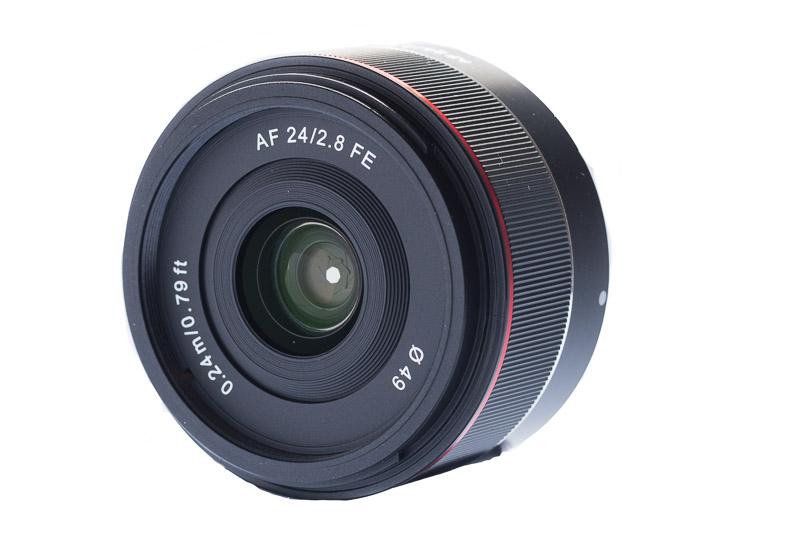
In my review of the Samyang AF 24mm f/2.8 FE I tell you why I think that Samyang has made a few compromises too many in order to keep it small.
Sample Images
Most images in this review can be found in full resolution here.
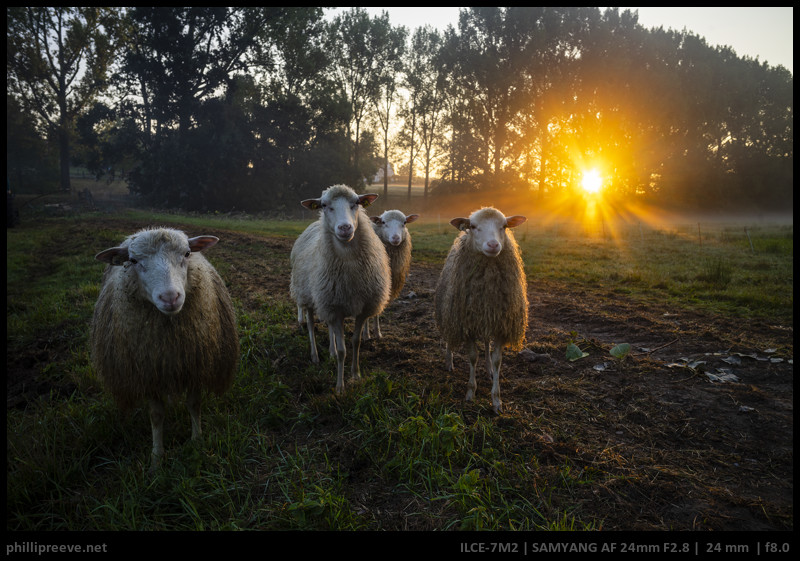
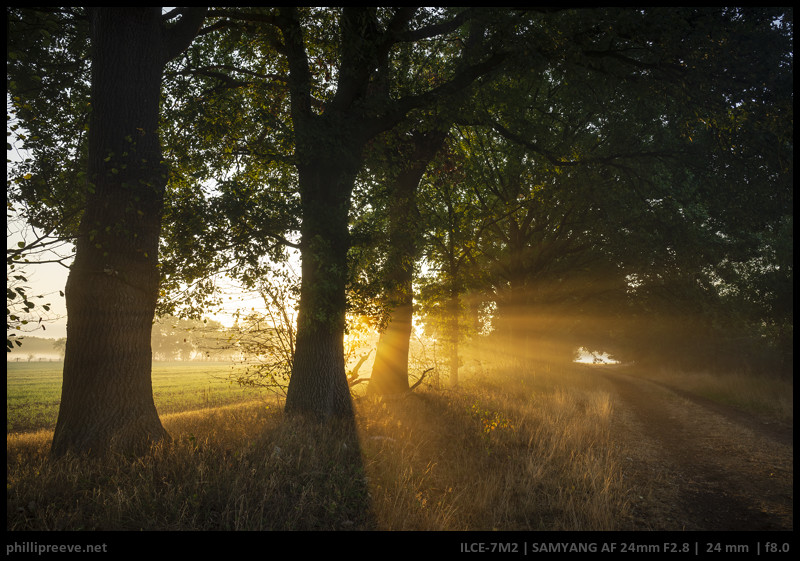
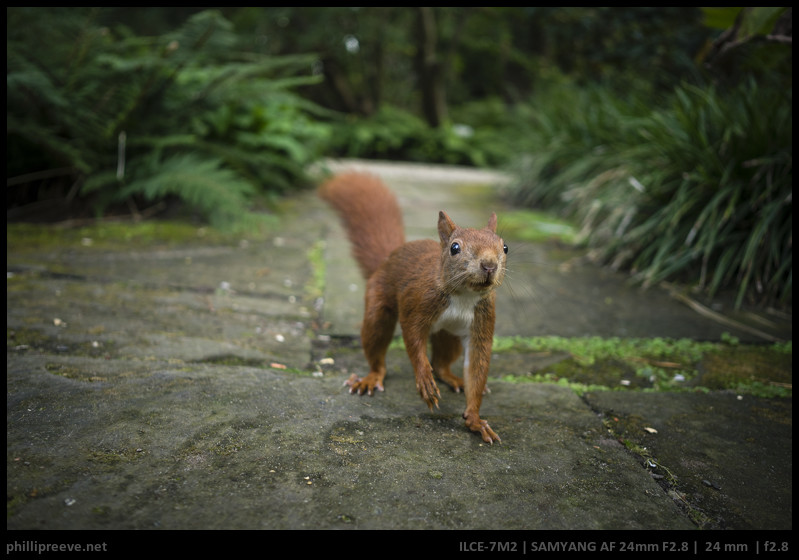
Specifications
| Diameter | 61 mm |
| Length | 37 mm |
| Filter Thread | 49 mm |
| Weight | 93 g |
| Max. Magnification | 1:6.4 |
| Close Focusing Distance from the sensor | 0.20 m |
| Number of aperture blades | 9 (rounded) |
| Elements/ Groups | 7/7 |
The Samyang 2.8/24 sells for $279 at amazon.com or B&H and for 299€ at amazon.de (affiliate links). If you purchase the lens through one of these affiliate-links I get a small compensation with no additional cost to you.
Contents
Build Quality
The Samyang has a metal mount but I think it is of less durable aluminium. The rest of the lens is made from plastics. The focusing ring is wide enough but doesn’t feel as smooth as that of most Sony FE lenses.
The lens hood is a bit flimsy, rather thin and cheap plastic. It is the right size to protect the front element from most damages but too small to really have any effect on the flare resistance.
In general the Samyang 2.8/24 feels a little cheap. Not as cheap as your typical $99 kit lens but Sony’s more affordable lenses feel nicer.
Samyang lenses have a reputation for failing more often and having higher variance than most competitor’s lenses. We certainly have had our share of bad copies from them (more than half). There is no public data on the newer AF-lenses but according to a trusted source they haven’t improved in this aspect. I think this is one reason why Samyang can offer their lenses at very competitive prices. This issue is in part offset by the generous warranties of up to 5 years.
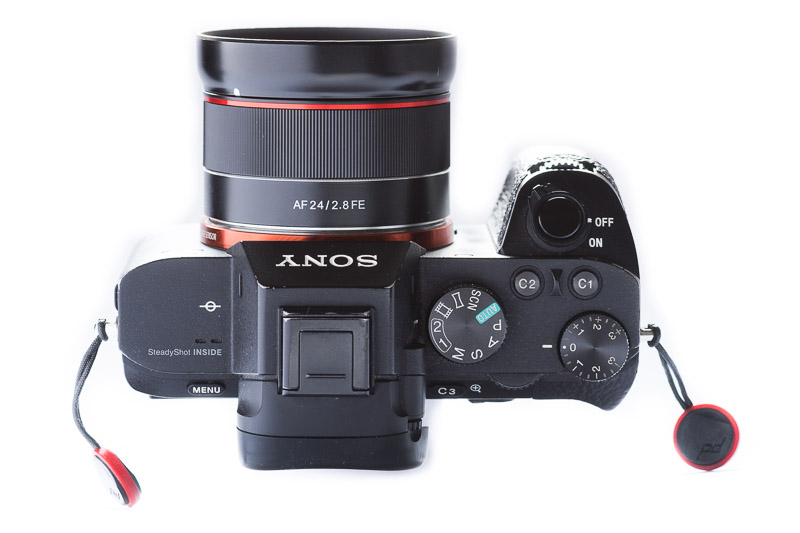 Size,Weight and Handling
Size,Weight and Handling
The 93g Samyang is a very small lens which makes the small FE 2/28 look big. Only Smayang’s own 2.8/35 is smaller and lighter.
The size is the Samyang’s most important quality. If your focus is on a very light and small kit then there is no real alternative to the tiny 2.8/24.

Manual Focus
As mentioned before the focusing ring feels ok with a little high resistance and a hard to describe lack of smoothness. I have used worse, but again every Sony lens has a nicer feeling focusing ring. As every other E-mount AF lens the focus is by wire but at least it does not depend on the speed with which you turn the focus ring. The focus throw is short at about 80 degrees. All in all a below average performance.
Autofocus
I used the Samyang 2.8/24 on the older a7II with a rather dated AF module. Usually it is a bit slow but reliable. Not so with the Samyang: I had higher number of misfocused images than I would have expected or had I used my FE 2/28 or FE 4/16-35. I didn’t investigate this further with another camera but it made me enjoy the Samyang even less.
AF is mostly quiet but at times you hear a scraping noise.
Optical performance
The Samyang has a narrower field of view than my other 24mm lenses so it is more like a true 25mm or 26 mm lens.
Bokeh
Out of focus highlights are rendered quite smoothly by the Samyang 2.8/24 but there are distinctive onion rings in some scenarios as well as significant bokeh fringing.

Scenario 1: Close Distance with demanding background
Scenario 2: Close focus, less demanding background
Scenario 3: Medium distance focus, demanding background
Scenario 4: long Distance with demanding Background
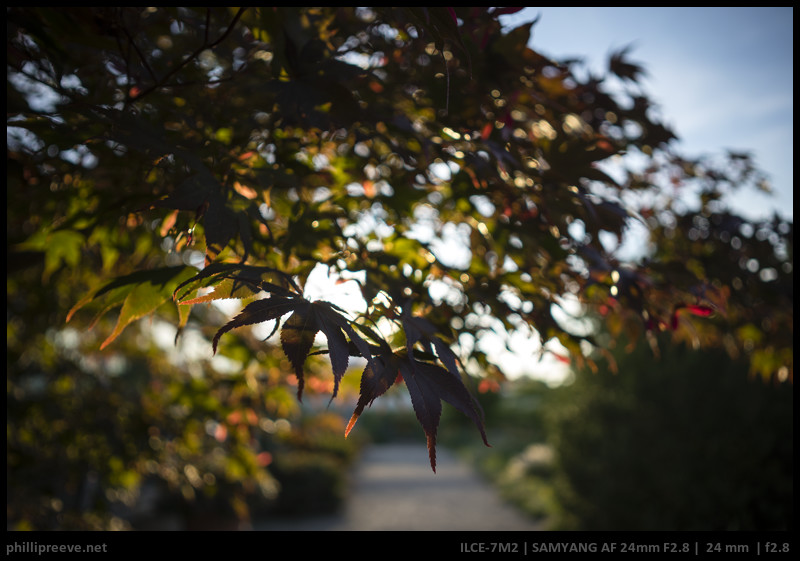
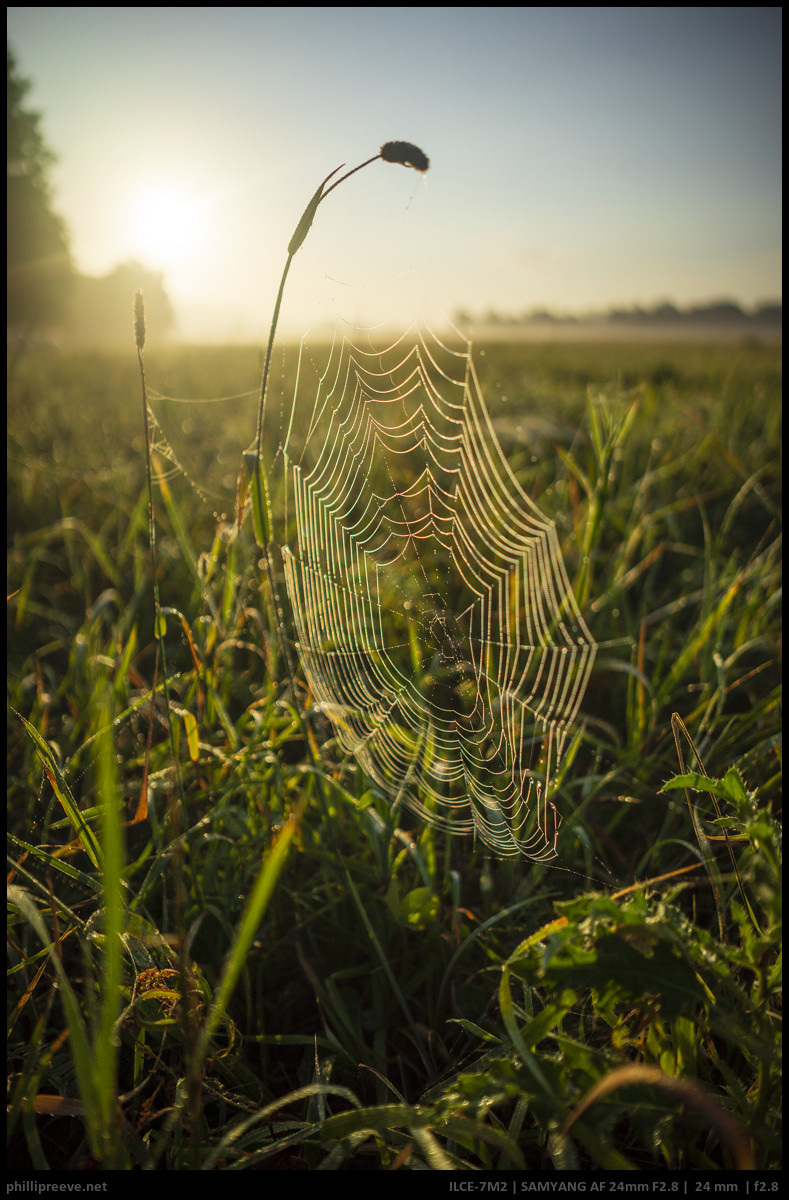
So for a wideangle bokeh is good in most scenarios but there are some scenarios where it gives less than ideal results.
Flare resistance
The Samyang’s flare resistance is below average by modern standards. There is very little ghosting but veiling flare is an issue in more demanding scenarios. I would rate it better than almost any legacy 24mm lens but on par with the FE 4/16-35. I took quite a few images where veiling flare resistance was a real issue and I find this to be pretty limiting for landscape photography.
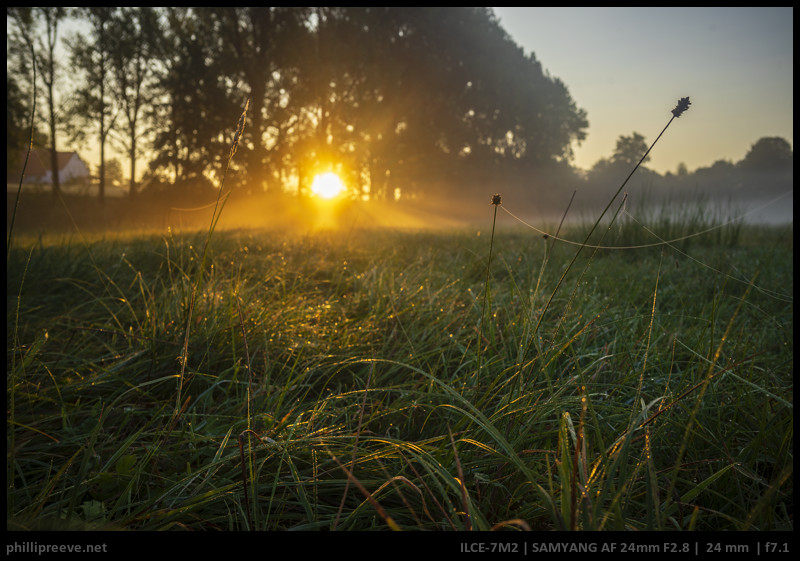
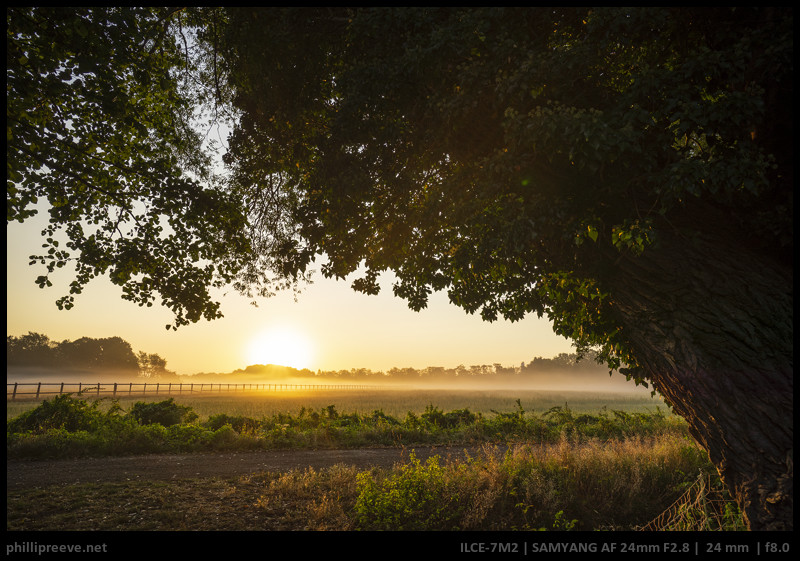
Vignetting
At 3.3 stops wide open the Samyang set a new record for any lens I have tested so far. This means that the extreme corners are basically at f/9 when the lens is used wide open. Numbers improve a little as you stop down but the remain close to two stops.
This is easily corrected but it costs some time and increases noise in the corners.
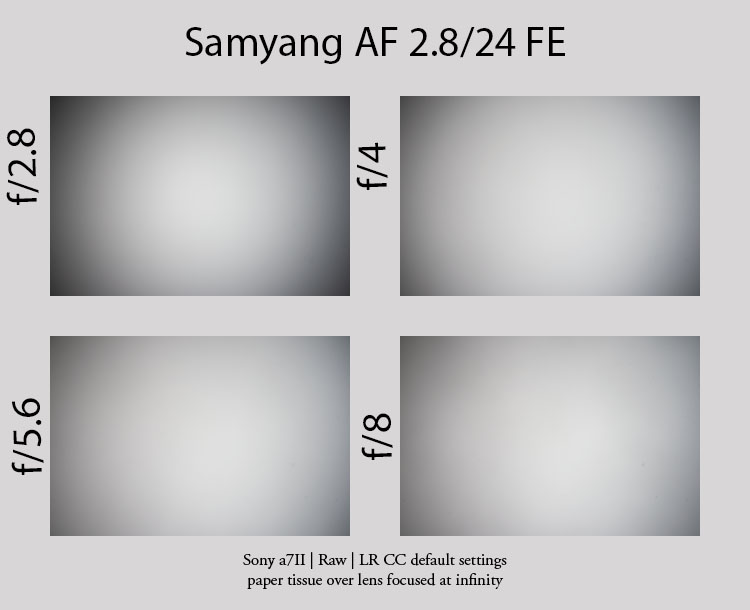
| Aperture | Vignetting |
| f/2.8 | 3.3 EV |
| f/4 | 2.5 EV |
| f/5.6 | 2.1 EV |
| f/8 | 1.9 EV |
| f/11 | 1.9 EV |
Distortion
The Samyang 2.8/24 displays pretty complex distortion which can’t be easily corrected by manual adjustments. -4 in LR gave the best results but visible distortion remains. At the time when I write this review (9/2018) the is no profile available in LR but this might change in the future.
before: no correction. after: -4 correction.Sunstars
Since the Samyang has 9 rouneded aperture blades you get fuzzy 18-pointed stars at most apertures. At f/16 they are somewhat defined by won’t excite anyone.
Sharpness
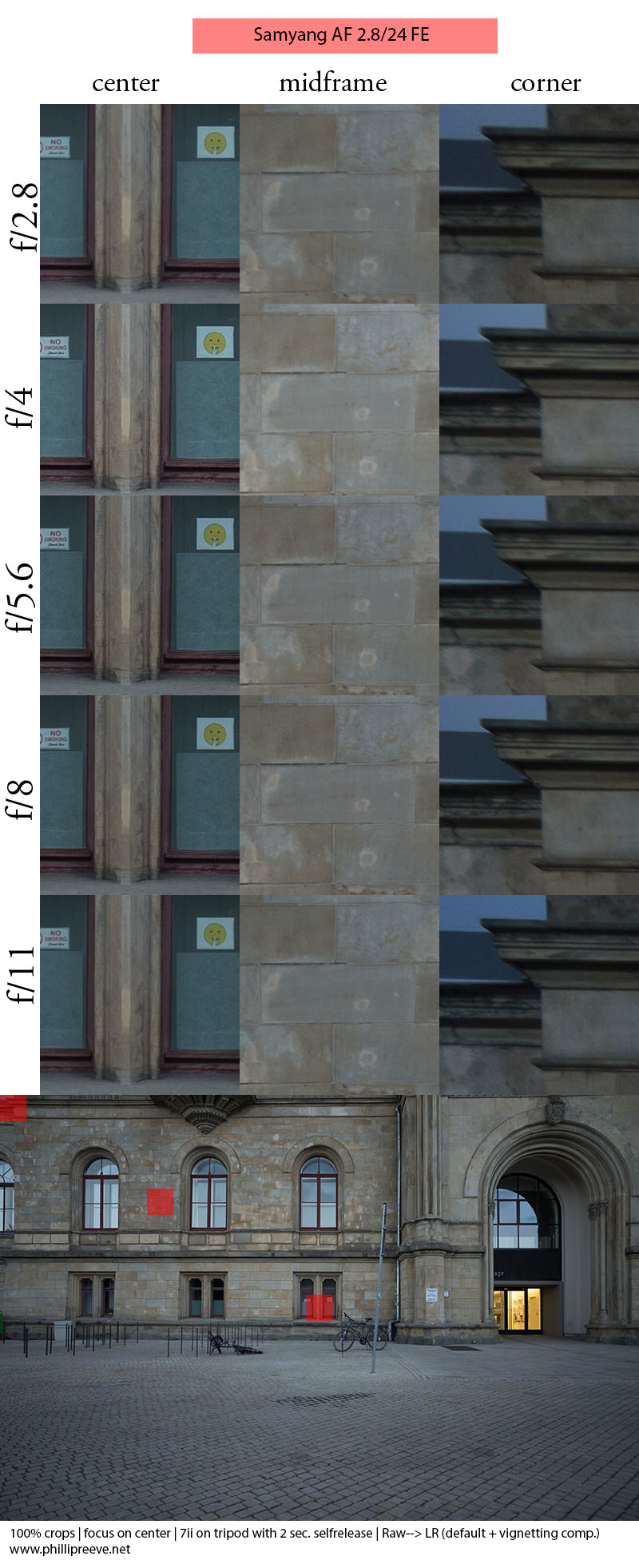
f/2.8:Good sharpness in the center, okayish midframe and softish corners..
f/4: Very sharp in the center, good in the midframe area und still softish corners.
f/5.6: Very good across most of the frame but the corners remain somewhat soft.
f/8: Corners are okay now.
f/11: Corners improve a little while the center is a tad softer.
Not a very impressive performance. The Samyang 24/2.8 FE is sharp enough for many applications but almost any competing lens is sharper.
Compared to other lenses
Voigtlander 3.5/21: The Voigtlander is also a very small lens but it weights and costs twice as much. I think it is a more attractive lens since it overcomes all the Samyang’s weaknesses except the strong vignetting.
The Sony FE 4/16-35 ZA is about five times as big and heavy and about three times as expensive. It is also a little sharper and much more versatile because of the larger zoom range.
Legacy 2.8/24 lenses. I compared the Samyang to the Minolta MD 2.8/24 (plan MD) which is one of the better classic 24mm lenses. I found the sharpness pretty similar (at f/8). The Samyang has better flare resistance, smoother bokeh and is much smaller AF while the Minolta is more affordable and more enjoyable to handle.
Zeiss Loxia 2.4/25: The half a stop faster, four times as heavy and much more expensive Loxia is of course the technically better lens. It is a lot sharper. From f/2.4 it is sharper across the frame than the Samyang ever gets. In regards to CA, contrast, flare resistance and sunstars the Loxia is also superior. So if you take your landscape photography serious go for the Loxia.
Zeiss Batis 2/25: A tiny little bit little weaker than the Loxia but bulkier and with AF it also runs circles around the Samyang.
Sony FE 2/28: The not much more expensive Sony weights 200g which is twice as much but very little overall. It outperforms the Samyang in any aspect but distortion and is a stop faster. Unlike with the Samyang I found the AF to be very reliable. So unless you put a lot of emphasis on small size I would always recommend the Sony over the Samyang. It is also a little wider than 28mm so rather close in focal length.
Conclusion
pros
|
average
|
cons
|
Every lens is a compromise between performance, price and size. The Samyang AF 2.8/24 FE puts a very small size and relatively low price over performance. and I would like to offer two points of view here.
If small size and low price are important to you the Samyang could be a very good fit: It is one of the smallest and most affordable E-mount lenses available and offers a good performance in most settings. I would prefer it over almost any legacy 24 mm lens which would perform worse overall and be much larger.
If on the other hand performance is very important to you then most alternatives will perform better the Samyang 2.8/24 needs to be stopped down to f/8 to deliver a sharp image and it retains very strong vignetting at these apertures. Even more annoying can be the the below average flare resistance which is very relevant for a wideangle lens.
Personally I didn’t warm to the Samyang AF 2.8/24. While appreciate the very small size and low price they come with a few compromises too many but I can see some appeal for very price and/or size minded photographers.
The Samyang 2.8/24 sells for $279 at amazon.com or B&H and for 299€ at amazon.de (affiliate links).
If this review was helpful to you, please consider using one of my affiliate links. I will receive a small commission on your purchase and there is no added cost to you. Thanks
More Sample Images
- Sony FE lenses: The honest Guide for the a7 series
- Guide to Macro Lenses for the Sony a7 series
- Long-term Review: Sony FE 2/28: A Smart Compromise
This site contains affiliate links. If you make a purchase using any of the links marked as affiliate links, I may receive a small commission at no additional cost to you. This helps support the creation of future content.
Latest posts by Phillip Reeve (see all)
- Review: Samyang AF 75/1.8 FE - April 12, 2021
- The FE-List now has 113 lenses on it - March 25, 2021
- 2020 – Year’s end review - December 28, 2020
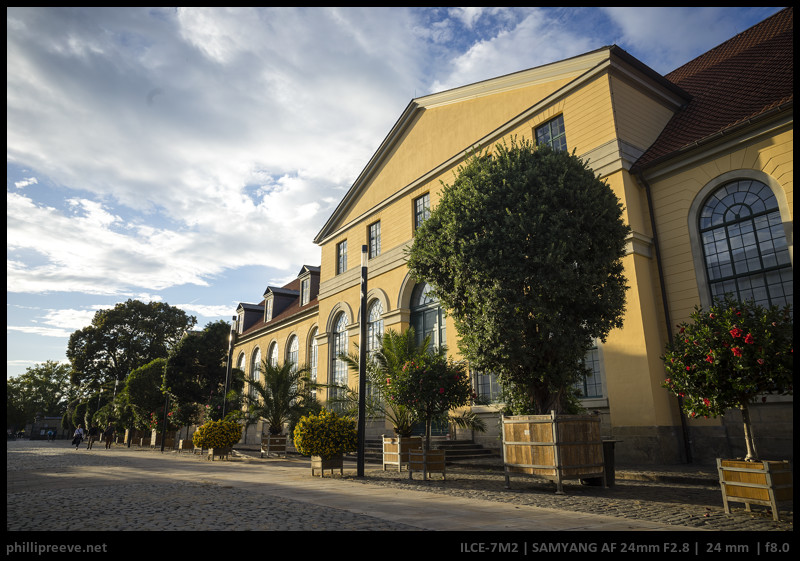








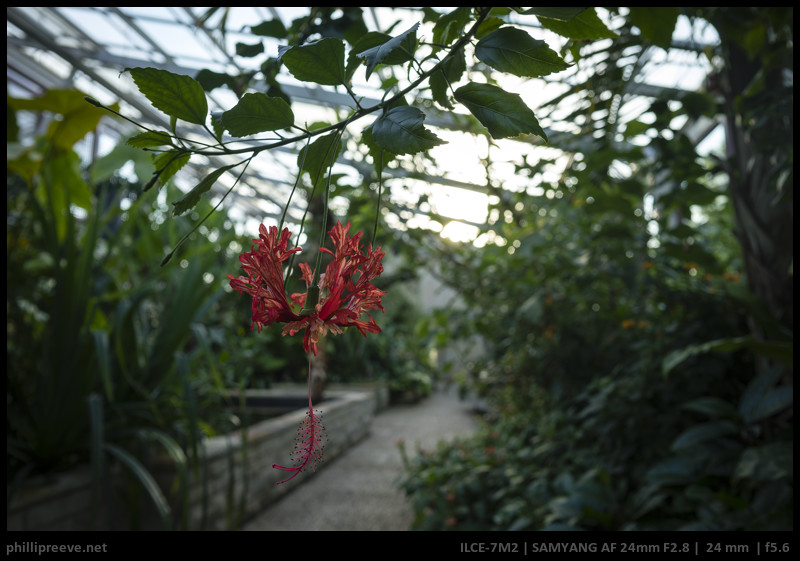
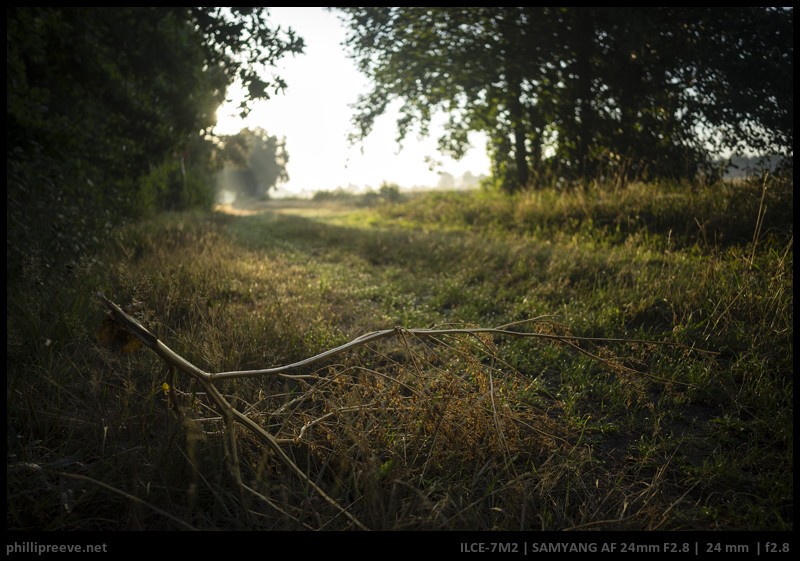

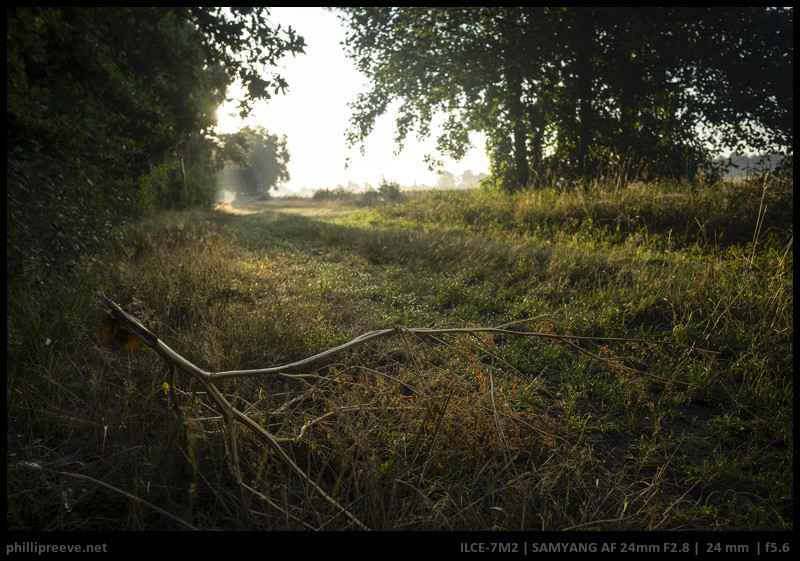
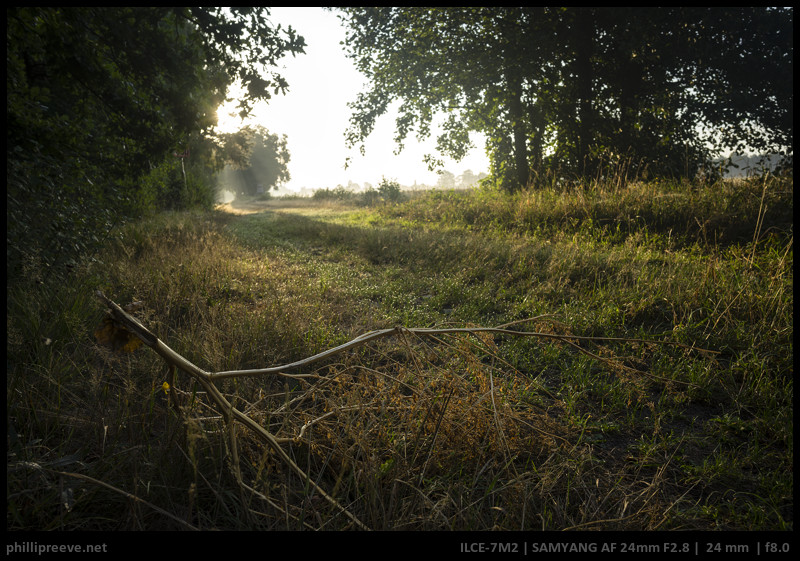
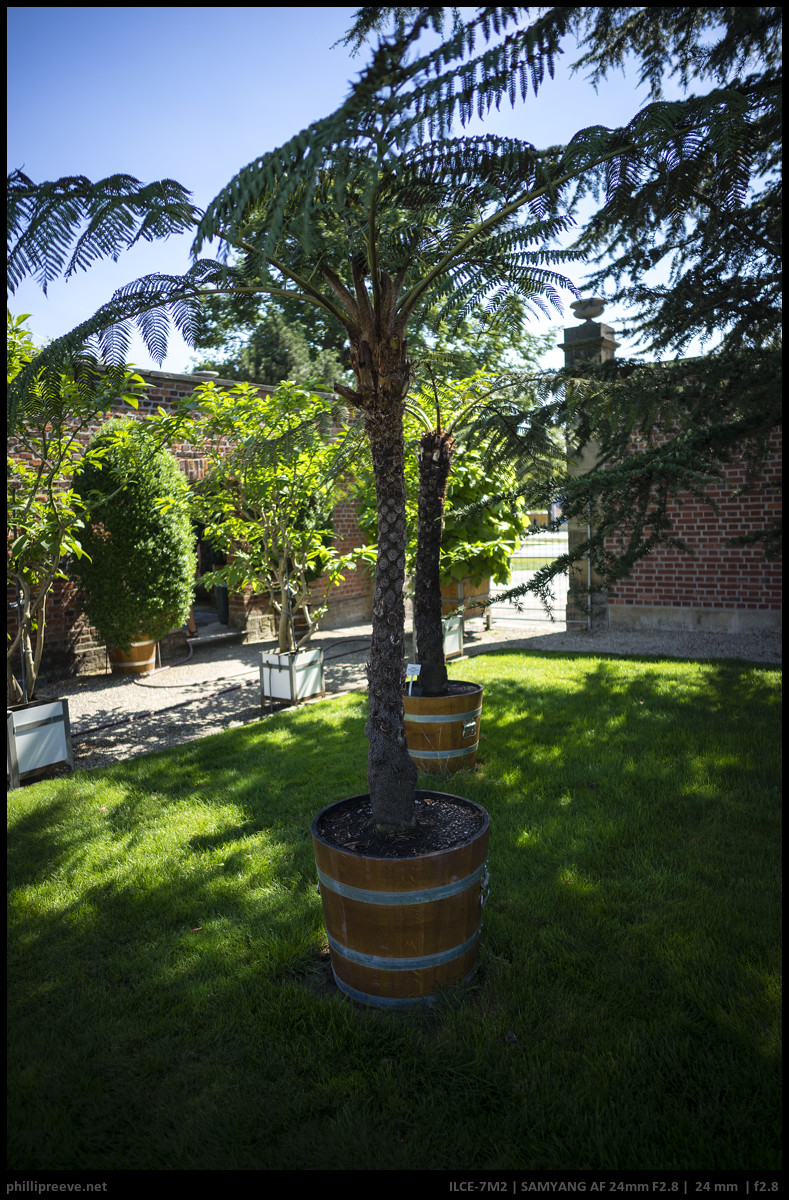
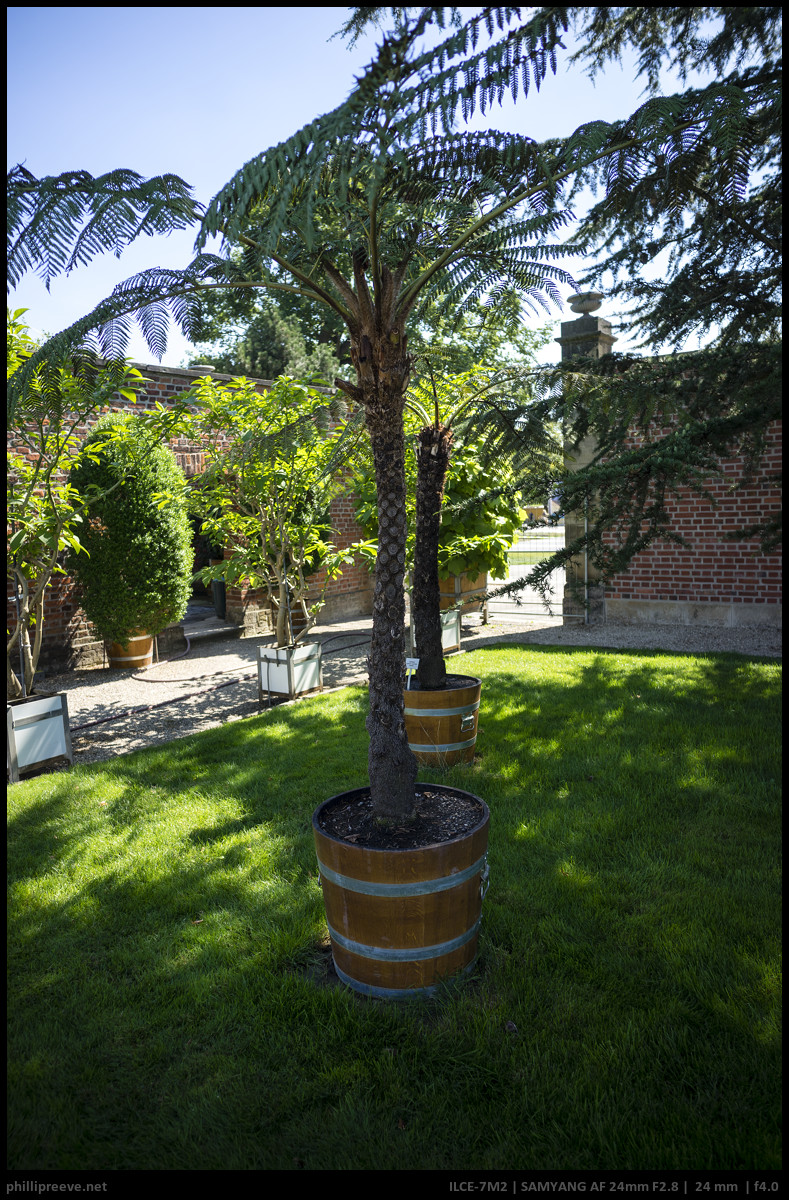



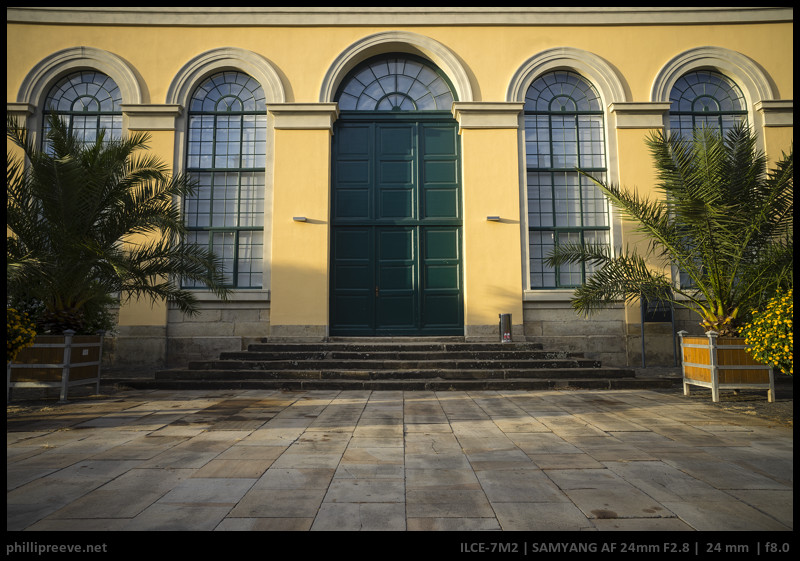
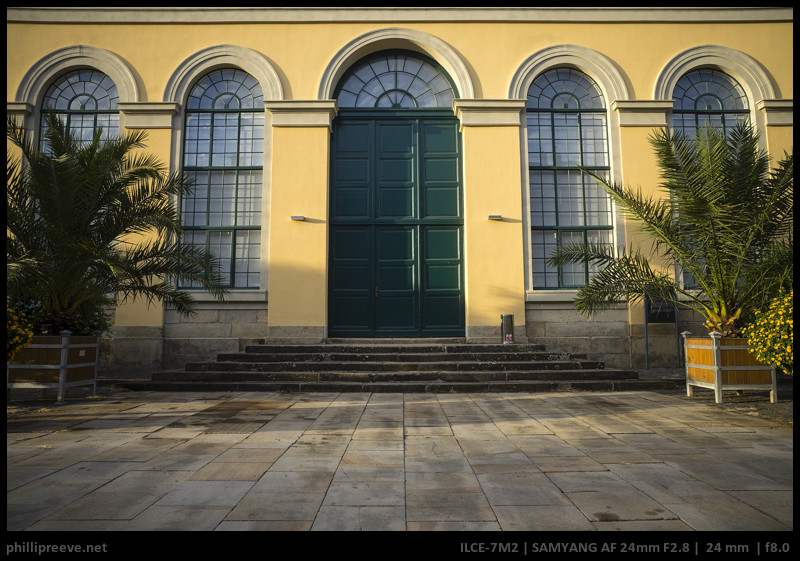





I got the lens when it ‘s released.During the days,I used it a lot.In my opion,the flare resistance is a big problem for me.So,I wanna know if it works better when i choose a bigger lens hood ?
Thanks.
I don’t know. Try shielding it with your hand and if that helps a different lens hood might help.
Before I sold mine (and I don’t miss it!) I bought a JJC screw-in hood. It improved flare dramatically, but by no means eliminated it.
I’ve been using this lens from its launch, but the AF performance is quite excellent in my A7m3. I’ve been using this lens for the video(with -x2 digital zoom in 4K) and reportage snap pictures. AF speed and accuracy was fine for both works, except AF-A, which was somewhat laggy.
l like this lens for its weight, almost identical or even lighter than my lens hoods. The Sharpness is okay-ish, but not quite comparable for other Sony primes and the contrast is somewhat undesirable. Overall it was my best option for my non-pro wide angle needs. I’m quite happy with that, I’d say it is not recommended for serious wide angle works.
Cheap,tiny,light lenses offer medium performance. The only lens i have tried in this category that is an exception is the canon ef 40 2.8 pancake which offers good performance. Bought the samyang 35 2.8 and sent it back after 2 weeks. The best compromise for lightness but twice as expensive is still the sony/zeiss 35 2.8. Better at infinite than the samyang,better corners for landscape and better colors.More robust too. Didn’t like the sony 28 f2 either.Distortion makes it poor for landscapes. This is my experience.Maybe it helps.Happy everything.
Any test of the Samyang 35mm f/2.8 coming up? It’s a bit easier to design, I’d be interested in your opinion! 🙂
By any report it is quite a bit better but after the frustrating experience with the 24mm I won’t be the one to review it.
I bought the 24mm and 35mm for a trip to Sicily, as I wasn’t sure what I’d need. The 35mm is definitely the better of the two, but suffers from similarly poor flare resistance, average corner performance and poor af-c performance above f7.1 or outside the PDAF area. I’ve owned two copies of the Zeiss before and from memory AF was significantly better, as was corner sharpness. For the money it’s a great lens, but again the 28mm is the better lens for everything except distortion.
Interesting review, thank you!
Because of the price I was quite interested in its performance, but the compromises made to keep the size down are too much.
I have had bad experience with the durability of Samyang lenses as well, the first sample of my 14mm had a scratch at one of the inner glass elements at the moment i bought it. The replacement’s corner sharpness degraded quickly over time (<2 years) so I brought it away for repair which costed almost as much as a new lens (no regrets of my insurance yet haha). I wonder if this bad reliability is still an issue in their newer lenses..
Wish you would have ran it against better vintage glass the Leica rokkor 24 comes to mind….. unless it’s really wide I think the old primes follow the 90 10 rule 90 percent of the performance for 10 percent of the price.i would be surprised if the Loxia is much better than the Minolta I reference…
I wouldn’t be. Not at all.
Well that depends a lot on your needs but the Loxia is a lot sharper, has higher contrast, much much better flare resistance and nicer sunstars. For me personally that is way more than 10 percent since I like to include the sun in many compositions.
I have the Leica Rokkor 24 and still use it quite a bit. One thing I will say for it is that it’s so much better on my A7RII than it was on my A7. Specifically shooting into the sun and other bright lights. IMO it was pretty much useless on the A7 because of sensor reflection (especially night city shots).
I will also add that it still doesn’t compare to the modern Loxias in this regard. However, if you’re pointing it away from bright light, it’s stellar.
Can you make a review of the Tokina Firin 20 mm f. 2.8?
I planned to buy this Samyang, but after this article I changed to the Firin. I should like to know how it performs though.
Already done 🙂
Thanks! I’ll sell my Canon gear and see if I can afford a Loxia? But Firin has autofocus now, and I like that too.
Hey Philipp, very nice review. I sign everything you said here because I made the exact same experience.
I ended up returning my copy and bought the 28 f2 Sony. It’s in my eyes way better and still not that big or expensive.
The only thing is that I would like something wider than 28 or even 24 with af and a filter tread but I don’t know any cheap lens in this category.
Talking about very small lenses, the Voigtlander Color Skopar 21mm f/3.5 was just announced.
http://www.cosina.co.jp/seihin/voigtlander/e-mount/e-21mm/index.html
I hope to see a blog post titled “Small lens, small compromise” in the near future!
Thank you for informing me! Here’s one more new, although a little bigger, but nice price!
– Viltrox PFU RBMH 20mm f/1.8 FE Manual Focus Lens: https://sonycamerarumors.net/surprise-viltrox-announced-three-new-lenses-for-sony-e-mount-mirrorless-cameras/
https://phillipreeve.net/blog/voigtlander-21mm-f35-review/
The first photo in the flare resistance comparison is utter bull. Sorry man, but in the first slide photo on the left you have a photo where you look into the sun and in the right version of the photo the sun is hidden behind the building, making the comparison useless.
That’s the whole point of the test: You see how the sun causes veiling flare which pollutes the shadows.
Wie nahe hast du denn beim Testen der Schärfe vor dem Haus gestanden? Mich wundert es irgendwie nicht, dass die so soft sind, wenn man nur auf die Bildmitte fokussiert, denn sie zeigen Teile, die deutlich weiter entfernt sind.
Man sollte sowieso immer Bilder ergänzen, die auf die Ecke fokussiert sind, denn es macht für viele einen erheblichen Unterschied, ob die Abbildungsqualität dort durchgängig mäßig ist oder ob es sich um Bildfeldwölbung handelt.
Interessant wäre zudem, wie der AF und die Bildqualität an den aktuellen Kameras mit BSI Sensoren sind, und an den Aps-c-Modellen.
Die Ecken sind in der selben Ebene wie das Zentrum. Bildfeldwölbung habe ich natürlich getestet: Ein Fokus auf die Ecken führt nur zu einer marginalen Verbesserung der Schärfeleistung.
Dilemma. buy this Samyang 24mm or via adapter Canon EF 24mm F2.8 is usm there ? For the same money.
Hi!
What would you say about the performance of this lense compared to let’s say the Canon Fd 24mm 2.8?
I enjoy using manual lenses but i also like having a smaller and lighter kit.
Thanks in advance!
Performance is pretty similar in my eyes and you characterized the defining features well.
Thanks for your reply!
Hi,
do you have any experience with the Tokina 20mm 2.8 or 24mm 2.8?
I’ve got an 35mm Sigma Art, and I’m looking for something wider, like 24, 20 or even 14. The Samyang 24 2.8 looked good, because I don’t want to spent as much money, it’s just for fun, not for business. Your review made me think, that i should be careful and overthink 😀
At the moment I’m looking at Samyang 24 2.8 / 14 2.8 and Tamron 20 2.8 / 24 2.8. Any advise or tip?
Best regards!
We have a review of the Tamron 24mm 2.8 as well.
None of these lenses you mentioned is overly great and easy to recommend without any hesitation.
They all come with certain compromises outlined in the reviews.
Which of these compromises is easiest to swallow for you we cannot tell.
I am a Canon R5 owner and would really like Samyang 24/2.8. Its what I am looking for hiking. I am waiting for RF mount with hope.
I backpack and hike and like to take people travel pictures while doing so. Light and small (to keep body from rolling while around my neck and light so its not fatigue) is perfect. My people pictures are not intended for art. A light 24mm lens is perfect for job. Once I get where I am going – its tilt shift lens and filters out of the pack.
The lower iq, lower weight, lower length, cheap price would be perfect for my R5 while hiking. I have the 7artisians 35/f5.6 on order but its 35. I might buy the voigt 21/3.5 but its expensive and 21.
Great job with your reviews. Thanks
I have one of these. Took some pictures at a family event; an 18th birthday. Fitted to Sony A7c. Tripod and remote control as I wanted to be in the group photo; maybe 20 people.
The lens focused on something but not where I wanted. Turned the camera off and on. Took the lens off and put it back. Made sure I selected manual focus. Disconnected the remote, used shutter button instead. Variations of this. No. It wouldn’t focus. I could almost hear it laughing at my discomfort.
A blurry picture has resulted, helped a bit in post, but it’s out of focus. Looks like something I took with my brownie 127…
Naturally it has worked fine since then, but all trust is gone.
Great reviews. Thanks
El samyang 24, 2,8 tendria mejor resultado con Sony A6000 ? (recortando esquinas mejora viñeteado ?)